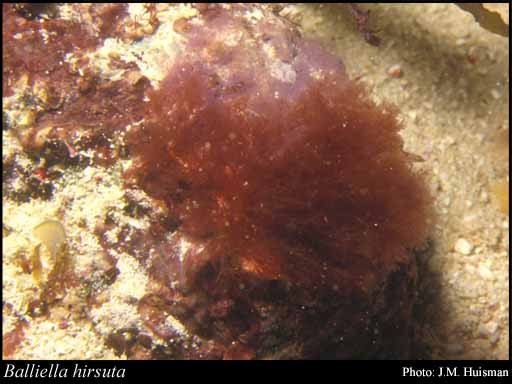- Reference
- Phycologia 459, figs 6-10 (1988)
- Conservation Code
- Not threatened
- Naturalised Status
- Native to Western Australia
- Name Status
- Current

Scientific Description
Habit and structure. Thallus erect, red, to 9 cm tall, filamentous, attached to the substratum by a single basal holdfast. Structure of uniseriate filaments with opposite-distichous branching, although occasionally a slight rotation is present between successive branch pairs to accommodate overlap of lateral branches. Lateral branches develop unequally - the apices of indeterminate axes are initially irregularly alternately or unilaterally branched, becoming opposite (1–)4–5(–10) cells from the apex. Indeterminate lateral branches occur alternately every (1–)2(–3) axial cells, replacing determinate lateral branches. Corticating rhizoids arise from the lower cells of both indeterminate and determinate lateral branches in the lower portions of the plant (usually at least 35 cells below the apex); these branch profusely and an extensive cortication is produced that closely envelops the supporting branch. Cells of indeterminate branches 300–750 µm long by 75–185 µm in diameter. Cells of determinate lateral branches 10–15 µm in diameter, with the basal cell twice as long as broad, other cells 4 times as long as broad. Spherical vesicular cells (9–17 µm in diameter), borne adaxially on basal cells of lateral branches and on cells of corticating rhizoids.
Reproduction. Plants dioecious, although occasionally with carpogonial branches and tetrasporangia on the same thallus. Carpogonial branch initials arise abaxially from the basal cells of lateral branches, divide obliquely and form a four-celled carpogonial branch that curls around the supporting cell and bears an elongate trichogyne that lies parallel with the main axis. After fertilization the trichogyne is cut off from the carpogonium by a pit connection and the auxiliary cell is produced adaxially from the supporting cell. After diploidization the auxiliary cell divides into a sterile foot cell and a gonimoblast initial, which then cuts off 4 to 6 clavate gonimolobe initials on which the spherical lobes of carposporangia are borne. Mature gonimolobes 150–250 µm in diameter, composed of carposporangia 20–30 µm in diameter. The gonimoblast initial, foot cell, supporting cell and axial cell bearing the supporting cell all fuse to some degree and appear to lose their contents, suggesting a nutritive function. Involucral branches arise from the supporting cell and other nearby cells and surround the gonimolobes. Spermatangia unknown. Tetrasporangia cruciately-divided, subspherical to elliposoidal, 35–45 µm long x 25–35 µm in diameter, borne either directly on cells of lateral branches or on a pedicel arising from them, generally adaxial, although occasional abaxial sporangia present.
Distribution. Known only from rocky reefs adjacent to Rottnest I., W. Aust.
Habitat. Plants grow epilithically on reefs and have been recorded from 10 m and 20 m depths.
[After Huisman, Phycologia 27: 459 (1988)]
Distribution
- IMCRA Regions
- Leeuwin-Naturaliste.
- Local Government Areas (LGAs)
- Cockburn.